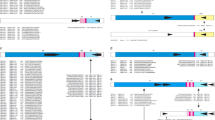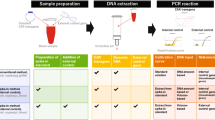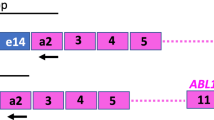Abstract
Several new therapeutic approaches for the treatment of monoclonal B cell lymphomas are currently being investigated. In parallel with new therapeutic modalities, more sensitive diagnostic methods are needed. These methods should be highly sensitive in detecting very low amounts of malignant cells and should be specific for the malignant clone. In addition, these methods should allow the quantification of residual tumor cells. In this study a new real-time polymerase chain reaction (LightCycler) was evaluated to quantify residual tumor cells in monoclonal B cell malignancies. This technology combines the advantages of rapid cycling PCR with the online detection of PCR products using fluorescent dyes. Our assay is based on immunoglobulin heavy chain (IgVH)-specific PCR with allele-specific primers complementary to hypervariable CDRII and CDRIII regions. A set of framework region III (FRIII)-specific hybridization probes was used for detection of the specific amplification product, and IgVH copy number was quantified with the cloned IgVH sequence as an external standard. The approach was evaluated with the Hodgkin lymphoma cell line L428 in order to quantify L428 dilutions. L428 cells mixed with peripheral blood mononuclear cells (PBMNCs) were detected and quantified with a sensitivity of one cell within 1 × 105 PBMNCs. Sample DNA from the peripheral blood and from the bone marrow of two patients with B-CLL was analyzed in the new set up at different time points before and after therapy. Statistically significant changes in IgVH copy numbers were documented in both patients. We conclude that this technology offers an additional opportunity to detect and quantify residual tumor cells in B-CLL over several log steps with a high sensitivity. The kinetics of residual tumor cell counts in B-CLL can be analyzed by this method.
This is a preview of subscription content, access via your institution
Access options
Subscribe to this journal
Receive 12 print issues and online access
$259.00 per year
only $21.58 per issue
Buy this article
- Purchase on Springer Link
- Instant access to full article PDF
Prices may be subject to local taxes which are calculated during checkout






Similar content being viewed by others
References
Byrd JC, Rai KR, Sausville EA, Grever MR . Old and new therapies in chronic lymphocytic leukemia: now is the time for a reassessment of therapeutic goals Semin Oncol 1998 25: 65–74
Czuczman M, Grillo-Lopez, AJ, McLaughlin P, Link BK, Rogers J, Cabanillas F, White CA, Shen CD, Varns C . IDEC-C2B8 clears bcl-2 (t14; 18) in patients (pts) with relapsed low grade or follicular lymphoma (LG/F NHL) (meeting abstract) Proc Annu Meet Am Assoc Cancer Res 1997
Jensen M, Winkler U, Manzke O, Diehl V, Engert A . Rapid tumor lysis oin a patient with B-cell chronic lymphocytic leukemia and lymphocytosis treated with an anti-CD20 monoclonal antibody (IDEC-C2B8, rituximab) Ann Hematol 1998 77: 89–91
Winkler U, Jensen M, Manzke O, Schulz H, Diehl V, Engert A . Severe cytokine-release syndrome in patients with B-cell chronic lymphocytic leukemia and high lymphocyte counts after treatment with an anti-CD20 monoclonal antibody (rituximab, IDEC-C2B8) Blood 1999 94: 2217–2224
Roberts W, Estrov Z, Zipf T . Detection of minimal residual disease in acute lymphoblastic leukemia (letter; comment) Blood 1995 86: 1237–1239
Maloum K, Pritsch O, Dighiero G . Minimal residual disease detection in B-cell malignancies by assessing IgH rearrangement Hematol Cell Ther 1997 39: 119–124
Schultze JL, Donovan JW, Gribben JG . Minimal residual disease detection after myeloablative chemotherapy in chronic lymphytic leukemia J Mol Med 1999 77: 259–265
Brisco MJ, Condon J, Hughes E, Neoh SH, Sykes PJ, Seshadri R, Toogood I, Waters K, Tauro G, Ekert H et al. Outcome prediction in childhood acute lymphoblastic leukaemia by molecular quantification of residual disease at the end of induction (see comments) Lancet 1994 343: 196–200
Lin F, Goldman J, Cross N . A comparison of the sensitivity of blood and bone marrow for the detection of minimal residual disease in chronic myeloid leukaemia (see comments) Br J Haematol 1994 86: 683–685
Cross N . Quantitative PCR techniques and applications Br J Haematol 1995 89: 693–697
Marcucci G, Livak KJ, Bi W, Strout MP, Bloomfield CD, Caligiuri MA . Detection of minimal residual disease in patients with AMLI/ETO-associated acute myeloid leukemia using a novel quantitative reverse transcription polymerase chain reaction assay Leukemia 1998 12: 1482–1489
Gerard CJ, Olsson K, Ramanathan R, Reading C, Hanania EG . Improved quantitation of minimal residual disease in multiple myeloma using real-time polymerase chain reaction and plasmid-DNA complementarity determining region III standards Cancer Res 1998 58: 3957–3964
Luthra R, McBride JA, Cabanillas F, Sarris A . Novel 5′ exonuclease-based real-time PCR assay for the detection of t (14; 18)(q32; q21) in patients with follicular lymphoma Am J Pathol 1998 153: 63–68
Pongers-Willemse MJ, Verhagen OJ, Tibbe GJ, Wijkhuijs AJ, de Haas V, Roovers E, van der Schoot CE, van Dongen JJ . Real-time quantitative PCR for the detection of minimal residual disease in acute lymphoblastic leukemia using junctional region specific TaqMan probes Leukemia 1998 12: 2006–2014
Wittwer CT, Herrmann MG, Moss AA, Rasmussen RP . Continuous fluorescence monitoring of rapid cycle DNA amplification Biotechniques 1997 22: 130–131, 134–138
Wittwer CT, Ririe KM, Andrew RV, David DA, Gundry RA, Balis UJ . The LightCycler: a microvolume multisample fluorimeter with rapid temperature control Biotechniques 1997 22: 176–181
Corradini P, Voena C, Omede P, Astolfi M, Boccadoro M, Dalla-Favera R, Pileri A . Detection of circulating tumor cells in multiple myeloma by a PCR-based method Leukemia 1993 7: 1879–1882
Corradini P, Voena C, Astolfi M, Ladetto M, Tarella C, Boccadoro M, Pileri A . High-dose sequential chemoradiotherapy in multiple myeloma: residual tumor cells are detectable in bone marrow and peripheral blood cell harvests and after autografting Blood 1995 85: 1596–1602
Corradini P, Astolfi M, Cherasco C, Ladetto M, Voena C, Caracciolo D, Pileri A, Tarella C . Molecular monitoring of minimal residual disease in follicular and mantle cell non-Hodgkin's lymphomas treated with high-dose chemotherapy and peripheral blood progenitor cell autografting Blood 1997 89: 724–731
Diehl V, Kirchner HH, Burrichter H . Characteristics of Hodgkin's disease-derived cell lines Cancer Treat Rev 1982 66: 615–632
Higuchi R . Simple and Rapid Preparation of Samples for PCR, In: Erlich HA (ed) PCR Technology Stockton Press: New York 1989 pp 31–38
Zwicky CS, Maddocks AB, Andersen N, Gribben JG . Eradication of polymerase chain reaction detectable immunoglobulin gene rearrangement in non-Hodgkin's lymphoma is associated with decreased relapse after autologous bone marrow transplantation Blood 1996 88: 3314–3322
Kueppers R, Hansmann ML, Rajewsky K . Micromanipulation and PCR analysis of single cells from tissue sections, In: Herzenberg LA, Weir D, Blackwell D (eds) Handbook of Experimental Immunology Blackwell Science: Oxford 1997 p 4
Sambrook J, Fritsch EF, Maniatis T . Molecular Cloning: A Laboratory Manual, 2nd edn Cold Spring Harbor Laboratory: Cold Spring Harbor, NY 1989
Wang Z, Spadoro J . Determination of target copy number of quantitative standards used in PCR-based diagnostic assays. In: Ferre F (ed). Gene Quantification Birkhäuser: Boston pp 33–43
Breslauer KJ, Frank R, Blocker H, Marky LA . Predicting DNA duplex stability from the base sequence Proc Natl Acad Sci USA 1986 83: 3746–3750
Jeffreys AJ, Wilson V, Neumann R, Keyte J . Amplification of human minisatellites by the polymerase chain reaction: towards DNA fingerprinting of single cells Nucleic Acids Res 1988 16: 10953–10971
Lankowicz JR . Energy transfer. In: Principles of Fluorescent Spectroscopy Plenum Press: New York 1989 pp . 303–339
Heid CA, Stevens J, Livak KJ, Williams PM . Real time quantitative PCR Genome Res 1996 6: 986–994
Ouspenskaia MV, Johnston DA, Roberts WM, Estrov Z, Zipf TF . Accurate quantitation of residual B-precursor acute lymphoblastic leukemia by limiting dilution and a PCR-based detection system: a description of the method and the principles involved (see comments) Leukemia 1995 9: 321–328
Provan D, Bartlett-Pandite L, Zwicky C, Neuberg D, Maddocks A, Corradini P, Soiffer R, Ritz J, Nadler LM, Gribben JG . Eradication of polymerase chain reaction-detectable chronic lymphocytic leukemia cells is associated with improved outcome after bone marrow transplantation Blood 1996 88: 2228–2235
Mensink E, van de Locht A, Schattenberg A, Linders E, Schaap N, Geurts van Kessel A, De Witte T . Quantitation of minimal residual disease in Philadelphia chromosome positive chronic myeloid leukaemia patients using real-time quantitative RT-PCR Br J Haematol 1998 102: 768–774
Acknowledgements
We thank Dr O Landt at TIB Molbiol for design of hybridization probes and Julia Jesdinski for sequencing.
Author information
Authors and Affiliations
Rights and permissions
About this article
Cite this article
Pfitzner, T., Engert, A., Wittor, H. et al. A real-time PCR assay for the quantification of residual malignant cells in B cell chronic lymphatic leukemia. Leukemia 14, 754–766 (2000). https://doi.org/10.1038/sj.leu.2401706
Published:
Issue Date:
DOI: https://doi.org/10.1038/sj.leu.2401706
Keywords
This article is cited by
-
Comparative analysis of minimal residual disease detection using four-color flow cytometry, consensus IgH-PCR, and quantitative IgH PCR in CLL after allogeneic and autologous stem cell transplantation
Leukemia (2004)
-
Detection of minimal residual disease in hematologic malignancies by real-time quantitative PCR: principles, approaches, and laboratory aspects
Leukemia (2003)
-
Incomplete DJH rearrangements as a novel tumor target for minimal residual disease quantitation in multiple myeloma using real-time PCR
Leukemia (2003)
-
Incomplete DJH rearrangements of the IgH gene are frequent in multiple myeloma patients: immunobiological characteristics and clinical implications
Leukemia (2003)
-
Significance of the levels of bone marrow lymphoid infiltrate in chronic lymphocytic leukemia patients with nodular partial remission
Leukemia (2002)



